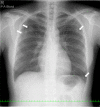Eosinophilic Pneumonia Associated With Natalizumab In A Patient With Multiple Sclerosis: A Case Report And Literature Review
- PMID: 31802879
- PMCID: PMC6831985
- DOI: 10.2147/TCRM.S225832
Eosinophilic Pneumonia Associated With Natalizumab In A Patient With Multiple Sclerosis: A Case Report And Literature Review
Abstract
We herein report the case of a 39-year-old Japanese female with eosinophilic pneumonia associated with natalizumab. The patient with bronchial asthma had multiple sclerosis and was treated using natalizumab. The patient was referred to our department because of a persistent cough. A chest computed tomography (CT) scan revealed bilateral patchy consolidation surrounded by ground-glass opacity. A bronchoalveolar lavage (BAL) was performed. Eosinophil levels in the BAL fluid were increased and the patient was consequently diagnosed as eosinophilic pneumonia associated with natalizumab. Therefore, natalizumab treatment was discontinued. Subsequent chest CT findings showed a remarkable improvement without any treatment.
Keywords: eosinophilic pneumonia; multiple sclerosis; natalizumab.
© 2019 Yasuda et al.
Conflict of interest statement
All of the authors report that they have no conflicts of interest to disclose in this work.
Figures





References
Publication types
LinkOut - more resources
Full Text Sources

